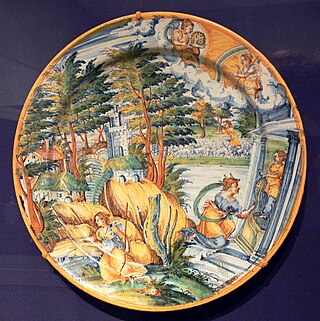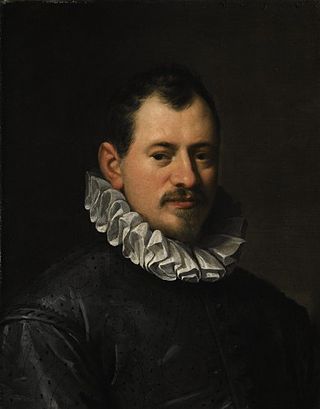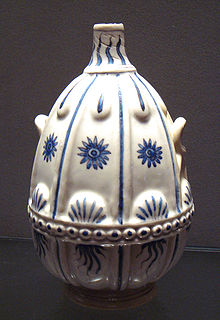
Delftware or Delft pottery, also known as Delft Blue or as delf, is a general term now used for Dutch tin-glazed earthenware, a form of faience. Most of it is blue and white pottery, and the city of Delft in the Netherlands was the major centre of production, but the term covers wares with other colours, and made elsewhere. It is also used for similar pottery, English delftware.

Porcelain is a ceramic material made by heating raw materials, generally including kaolinite, in a kiln to temperatures between 1,200 and 1,400 °C. The greater strength and translucence of porcelain, relative to other types of pottery, arise mainly from vitrification and the formation of the mineral mullite within the body at these high temperatures. End applications include tableware, decorative ware such as figurines, and products in technology and industry such as electrical insulators and laboratory ware.

Faience or faïence is the general English language term for fine tin-glazed pottery. The invention of a white pottery glaze suitable for painted decoration, by the addition of an oxide of tin to the slip of a lead glaze, was a major advance in the history of pottery. The invention seems to have been made in Iran or the Middle East before the ninth century. A kiln capable of producing temperatures exceeding 1,000 °C (1,830 °F) was required to achieve this result, the result of millennia of refined pottery-making traditions. The term is now used for a wide variety of pottery from several parts of the world, including many types of European painted wares, often produced as cheaper versions of porcelain styles.

A vase is an open container. It can be made from a number of materials, such as ceramics, glass, non-rusting metals, such as aluminium, brass, bronze, or stainless steel. Even wood has been used to make vases, either by using tree species that naturally resist rot, such as teak, or by applying a protective coating to conventional wood or plastic. Vases are often decorated, and they are often used to hold cut flowers. Vases come in different sizes to support whatever flower is being held or kept in place.

Islamic pottery occupied a geographical position between Chinese ceramics, and the pottery of the Byzantine Empire and Europe. For most of the period, it made great aesthetic achievements and influence as well, influencing Byzantium and Europe. The use of drinking and eating vessels in gold and silver, the ideal in ancient Rome and Persia as well as medieval Christian societies, is prohibited by the Hadiths, with the result that pottery and glass were used for tableware by Muslim elites, as pottery also was in China but was much rarer in Europe and Byzantium. In the same way, Islamic restrictions greatly discouraged figurative wall painting, encouraging the architectural use of schemes of decorative and often geometrically patterned titles, which are the most distinctive and original specialty of Islamic ceramics.

Maiolica is tin-glazed pottery decorated in colours on a white background. The most renowned Italian maiolica is from the Renaissance period. These works were known as istoriato wares when depicting historical and mythical scenes. By the late 15th century, multiple locations, mainly in northern and central Italy, were producing sophisticated pieces for a luxury market in Italy and beyond. In France, maiolica developed as faience, in the Netherlands and England as delftware, and in Spain as talavera. In English, the spelling was anglicised to majolica, but the pronunciation usually preserved the vowel with an i as in kite.

Soft-paste porcelain is a type of ceramic material in pottery, usually accepted as a type of porcelain. It is weaker than "true" hard-paste porcelain, and does not require either its high firing temperatures or special mineral ingredients. There are many types, using a range of materials. The material originated in the attempts by many European potters to replicate hard-paste Chinese export porcelain, especially in the 18th century, and the best versions match hard-paste in whiteness and translucency, but not in strength. But the look and feel of the material can be highly attractive, and it can take painted decoration very well.

Tin-glazing is the process of giving tin-glazed pottery items a ceramic glaze that is white, glossy and opaque, which is normally applied to red or buff earthenware. Tin-glaze is plain lead glaze with a small amount of tin oxide added. The opacity and whiteness of tin glaze encourage its frequent decoration. Historically this has mostly been done before the single firing, when the colours blend into the glaze, but since the 17th century also using overglaze enamels, with a light second firing, allowing a wider range of colours. Majolica, maiolica, delftware and faience are among the terms used for common types of tin-glazed pottery.

Edmé Samson, founder of the porcelain firm Samson, Edmé et Cie, was a famous copyist of porcelain and pottery. The firm produced high-quality copies or imitations of earlier styles of porcelain, mainly 18th-century European and Chinese and Japanese porcelain, but also earlier styles such as Italian maiolica.

Fritware, also known as stone-paste, is a type of pottery in which frit is added to clay to reduce its fusion temperature. The mixture may include quartz or other siliceous material. An organic compound such as gum or glue may be added for binding. The resulting mixture can be fired at a lower temperature than clay alone. A glaze is then applied on the surface.

Tin-glazed pottery is earthenware covered in lead glaze with added tin oxide which is white, shiny and opaque ; usually this provides a background for brightly painted decoration. It has been important in Islamic and European pottery, but very little used in East Asia. The pottery body is usually made of red or buff-colored earthenware and the white glaze imitated Chinese porcelain. The decoration on tin-glazed pottery is usually applied to the unfired glaze surface by brush with metallic oxides, commonly cobalt oxide, copper oxide, iron oxide, manganese dioxide and antimony oxide. The makers of Italian tin-glazed pottery from the late Renaissance blended oxides to produce detailed and realistic polychrome paintings.

The Doccia porcelain manufactory, at Doccia, a frazione of Sesto Fiorentino, near Florence, was in theory founded in 1735 by marchese Carlo Ginori near his villa, though it does not appear to have produced wares for sale until 1746. It has remained the most important Italian porcelain factory ever since.
Marco Spallanzani is an economic historian who previously taught economic history at the University of Florence. For some time he has conducted research in the Tuscan archives on the production and trade of goods considered to be ‘minor arts,’ examining, through various products from the east, the moment of their importation from the lands of Islam or faraway China. He has published articles on the presence of these much sought-after furnishings by the Medici and the most important families of the 14th–16th centuries. He has also edited an edition of Medici family inventories of the quattrocento. In 1982, he set up the Islamic Hall of the Bargello art museum in Florence.

French porcelain has a history spanning a period from the 17th century to the present. The French were heavily involved in the early European efforts to discover the secrets of making the hard-paste porcelain known from Chinese and Japanese export porcelain. They succeeded in developing soft-paste porcelain, but Meissen porcelain was the first to make true hard-paste, around 1710, and the French took over 50 years to catch up with Meissen and the other German factories.

Rouen porcelain is soft-paste porcelain made in the city of Rouen, Normandy, France, during a brief period from about 1673 to 1696. It was the earliest French porcelain, but was probably never made on a commercial basis; only nine pieces are now thought to survive.

China painting, or porcelain painting, is the decoration of glazed porcelain objects such as plates, bowls, vases or statues. The body of the object may be hard-paste porcelain, developed in China in the 7th or 8th century, or soft-paste porcelain, developed in 18th-century Europe. The broader term ceramic painting includes painted decoration on lead-glazed earthenware such as creamware or tin-glazed pottery such as maiolica or faience.

Ceramic art is art made from ceramic materials, including clay. It may take varied forms, including artistic pottery, including tableware, tiles, figurines and other sculpture. As one of the plastic arts, ceramic art is a visual art. While some ceramics are considered fine art, such as pottery or sculpture, most are considered to be decorative, industrial or applied art objects. Ceramic art can be created by one person or by a group, in a pottery or a ceramic factory with a group designing and manufacturing the artware.

Cozzi porcelain is porcelain made by the Cozzi factory in Venice, which operated between 1764 and 1812. Production included sculptural figurines, mostly left in plain glazed white, and tableware, mostly painted with floral designs or with figures in landscapes and buildings, in "bright but rough" colours. They were rather derivative, drawing from Meissen porcelain in particular in the early years.

Jacques Bylivelt, also known as Giacomo Giovanni Bilivert or Jacopo Biliverti was a Dutch goldsmith and jeweler who worked for the Medicis.

The Museum Giuseppe Gianetti is a ceramics museum located in Saronno, Italy. The Museum includes collections of different types of porcelain, majolica, and ceramics that belonged to the Italian industrialist Giuseppe Gianetti. These showcase more than 200 pieces of Meissen porcelain, which represents the Museum's most substantial collection. Other collections cover Oriental porcelain, Italian and European majolica, and porcelain. The original collections have been expanded to include the Aldo Marcenaro Collection and a collection of contemporary ceramics.


























